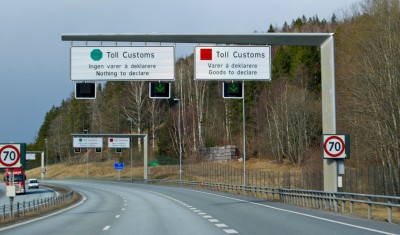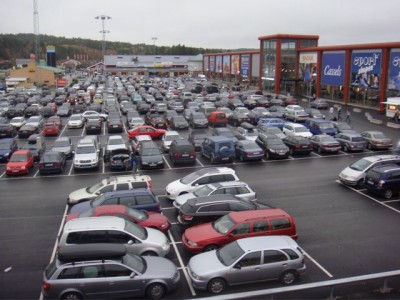Food prices in Norway rose again from January to February, reported state statistics bureau SSB on Friday. The news comes as legions of Norwegians would likely drive over the border during the weekend to do their shopping in Sweden, where prices are much lower and selection much higher.

SSB reported that prices for vegetables and fruit, dairy products, meat and cereal rose 0.9 percent and were an important part of an overall price rise of 1.3 percent. “Prices increased both on the domestic market and for imported goods,” reported SSB.
The state statistics bureau earlier this week reported that Norwegians set yet another record for cross-border trade last year, with fully 94 percent of it occurring in neighbouring Sweden. SSB statisticians said Norwegians spent NOK 11.5 billion outside the country in 2011, up 9 percent from the year before.
All told, Norwegians took around 7 million day trips to shop over the border. The reason is simple: Prices for food and other grocery store products from beer to shampoo can be as much as 40 percent lower in a Swedish store, and there are more brands from which to choose. Interestingly most of the increase in total shopping was at general merchandise and grocery stores, with Sweden state-controlled liquor retailer Systembolaget reporting only a 0.6 percent increase at its outlets along the Norwegian border. Alcoholic beverages are no longer the main magnet for Norwegian shoppers.

Norwegians are instead traveling outside the country far more often for general household shopping, not just to buy cheaper liquor or tobacco, and they’re spending even more money than before. Norwegian employers’ organization Virke has made some calculations of its own, and estimates that fully 6 percent of Norway’s market for grocery items and beverages has now moved across the border to Sweden. Meat and dairy products are what Norwegians buy most in Sweden, according to Virke, because of big price differences.
That means that Norway’s own state treasury is losing around NOK 2.5 billion in taxes and fees alone, along with around 10,000 jobs, according to Virke.
“That’s an awful lot,” Thomas Angell, director of trade for Virke, told newspaper Dagsavisen. “It worries us, because these are sales Norwegian merchants should have had. Both the merchants and their suppliers are losing revenues and employment possibilities.”
‘Misguided’ policies
Angell blames it all, as do many frustrated consumers in Norway, on what he calls “misguided” agricultural and tax policies, many of which have simply gone out of date given the options Norwegian consumers now have. Norway’s highly protectionist tariff systems and highly regulated markets like those for dairy products and meat make prices so high in Norway, that those who can, head to Sweden to beat the system and save money.
Taxes and fees also enter the equation, but Sweden also has a high VAT on most products and services, and restrictive alcohol policies. That means there must be other explanations, from protectionism to Norwegian wholesalers’ greed, for why food and sundries are so much cheaper in Sweden than in Norway.
Many Norwegians drive to Sweden, for example, to have their cars repaired. There are no special import tariffs on car parts in Norway and VAT is the same, reported newspaper Aftenposten recently, yet prices are much lower in Sweden. Suspicions have thus risen that a wide range of businesses from dairy to personal care and automotive products in Norway have simply charged what they think the local market will pay. They now stand to lose customers who can shop elsewhere.
‘Politicians hold the key’
Fully 52 percent of the money spent outside Norway is spent in Sweden’s Strømsad-Svinesund region south of Oslo, according to SSB, with 19 percent spent in Sweden’s Charlottenberg-Arvika region. They’re the easiest to reach from the largest centers of Norway’s populations, and several entrepreneurial Norwegians like real estate tycoon Olav Thon have invested heavily there to cash in themselves on their fellow Norwegians’ shopping trends. They know that Norwegians will be lured by the promise of lower prices, even though their savings can be eaten up by the sheer transport costs of getting there. That reinforces the notion that many Norwegians simply enjoy making a day-trip for shopping in Sweden, if only to exercise their freedom of choice.
The latest large increase in border trade “just shows there is no room for more agricultural support that will lead to even more expensive food for Norwegians, or tax increases that will yield more savings in Sweden,” said Angell. “Norwegian politicians hold the key to change these shopping trends.”
Norway’s powerful and vocal farming lobby clearly disagrees and is asking for more government support as they enter the annual round of subsidy and policy negotiations. They say the support and higher prices are critical if Norway is to maintain food production of its own.
Angell has support from from at least one party in Parliament. “We think this development (of ever-rising border trade) is serious and we’re working to bring up the issue in Parliament,” Ketil Solvik Olsen, financial spokesman for the conservative Progress Party, told Dagsavisen. “The numbers show that the need for debate is great.”
Views and News from Norway/Nina Berglund
Please support our stories by clicking on the “Donate” button now:

